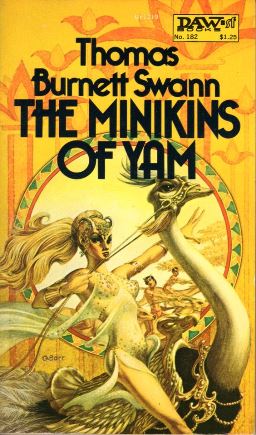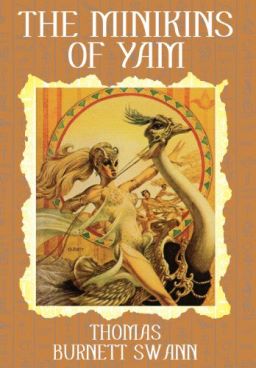Adventure in The Old Kingdom: The Minikins of Yam by Thomas Burnett Swann

I am on holiday and, while taking a break from work, am also taking a short break from my ongoing retro review of Jane Gaskell’s Atlan Saga. My growing Books to Read shelf produced two volumes that spoke to me: The Minikins of Yam by Thomas Burnett Swann, and Swords Against Death by Fritz Leiber. The latter has been well reviewed and discussed on the Black Gate blog, but Swann has received a lot less attention.
Thomas Burnett Swann (1928 to 1976) wrote a number of books, essays and short stories during his career, but seems to have been most prolific during his later years. He is an author I have never read before, and I picked up the DAW copy of The Minikins of Yam at a second hand book shop for the huge sum of ZAR12 (about 80 cents).
The cover and age intrigued me and when I glanced at the first three lines: “Egypt. Chemmis. The palace of Pharaoh,” I was hooked. I have always been fascinated with ancient Egypt, and this book spoke to me. While Mr Swann was not familiar to me, he has appeared before in Black Gate, in blog posts about his novels The Weirwoods and Wolfwinter by John O’Neill.
The volume I read is a slim 156 pages and was published by DAW books in 1976, so it may be one of the last books the author saw published in his lifetime. The only later edition appears to have been from Wildside Press in 2013. The DAW edition includes a few internal illustrations by the prolific George Barr, who also did the cover, featuring a near-naked satyr like creature (a minikin) riding an ostrich.
The story commences with the juvenile Pharaoh, Pepy II, in Old Kingdom Egypt, where the lonely young Pharaoh sneaks out each night in disguise to help the poor. Next wee meet the Pharaoh’s father-like friend Harkhuf, an accomplished soldier and adventurer, who has traveled beyond Nubia into the land of Yam in search of a black dwarf, whom the Pharaoh would be pleased to see dance in his court.
The blurb on the back of the book reads:
Swann’s neo-romantic fantasies of the past are unique. He uses the stuff of myth butwith twists and innovations of his own.” So wrote The Village Voice(New York) and such have been the views of Swann’s legion of devotees. In this, his latest novel, Swann takes the reader to Ancient Egypt, the Egypt o Pharaohs and beast-headed gods, beyond whose borders lay the jungles and kingdoms of whisper and legend.
This is the story of a young Pharaoh, of his journey beyond those mythic borders, of his meeting with ghosts, gods, and the marvelous minikins. It is a Swann novel to rank with How Are the Mighty Fallen and Green Phoenix in esteem of fantasy readers.
“It is an author’s lot to be compared to other writers and his works to others. I would be greatly surprised to find Swann objecting to the company of Ray Bradbury, Frank Herbert and Mary Renault….” (Maybe: Worlds of Fandom).
Yam itself is, as best I can tell, south of Nubia, somewhere near where the ancient Egyptians (and Hyboreans — REH fans) believed the kingdom of Punt to exits, vis-à-vis somewhere around South Sudan, perhaps even further down into the modern day Uganda and Lake Victoria’s environs. What is interesting is that, when I started looking into the back story, it seems General Harkhuf did exist, and did indeed please his Pharaoh by returning from a distant adventure with a captive pygmy.

The book swings between Harkhuf’s adventures and events at court, where the skulduggery standard to a Pharaoh’s reign is afoot. Pepy II’s older sister Henna and a priest are conspiring to have him sacrificed — for the good of Egypt, naturally — which will save them from drought and other ill portents that Henna has dreamed of. Fleeing south back to Yam on the back of a Roc, which the minikin Immortelle has called, Harkhuf, Pepy II, his friend Tike and Immortelle are joined by the ka of Harkhuf’s deceased wife Ti and the djinn of Immortelle’s fellow minikin and lover Tete. The odd band must consult the ancient god Nilus to query why he might withhold his annual flood, and furthermore they have to seek out a mythical Green Lotus.
The book is short, and for the most part deals with the banishment of magic which Pepy II’s father had caused with a great exorcism some years before. While I enjoyed it and the subject matter, I doubt the book will entertain everyone. I liked Mr Swann’s technique, his usage of obscure words and humor, which had me smiling at some of the things Harkhuf thought and did.
Some may however see this book as pretty sexist, or at least the author may have been a bit over-the-top in his enthusiastic descriptions of breasts and whores. But I prefer to think he was using these as mechanisms to set the scene, and differentiate the culture of the Old Kingdom from that of today.
There are a few small issues which may easily be forgiven. Such as people travelling to Africa to visit the temple of an Indian god (Ganesh) or that Baobab trees yield good wood for timber (they do not, their wood is spongy) but these may easily be forgiven, or simply be written off as narrative relics of a different place and different time. Overall I enjoyed the book as an entertaining, brief read and would recommend it to anyone keen on ancient Egypt, but would also warn that it may not be for everyone.
Pepy II reigned during Eqypt’s sixth dynasty and was one of the last Pharaohs to build a pyramid. His pyramid has sadly not lasted as well as those of previous dynasties. He was also purportedly the Pharaoh who reigned the longest of all, across the various kingdoms. A little more information regarding Yam, Pepy II and Harkhuf’s adventures may be found at:
Ah, Thomas Burnett Swan. Not for everyone indeed. For me he will always be a truly unique writer whose depth of feeling and genuine inventiveness are doomed to be cancelled out by their corresponding vices – sentimentality and lack of control of his material.
Anyone interested in seeing what can be made of similar materials by a VERY different sensibility should try Avram Davidson’s ancient fantasy, The Phoenix and the Mirror.
Well said Thomas. Thanks for the tip re Avram Davidson, I will keep an eye open for it.